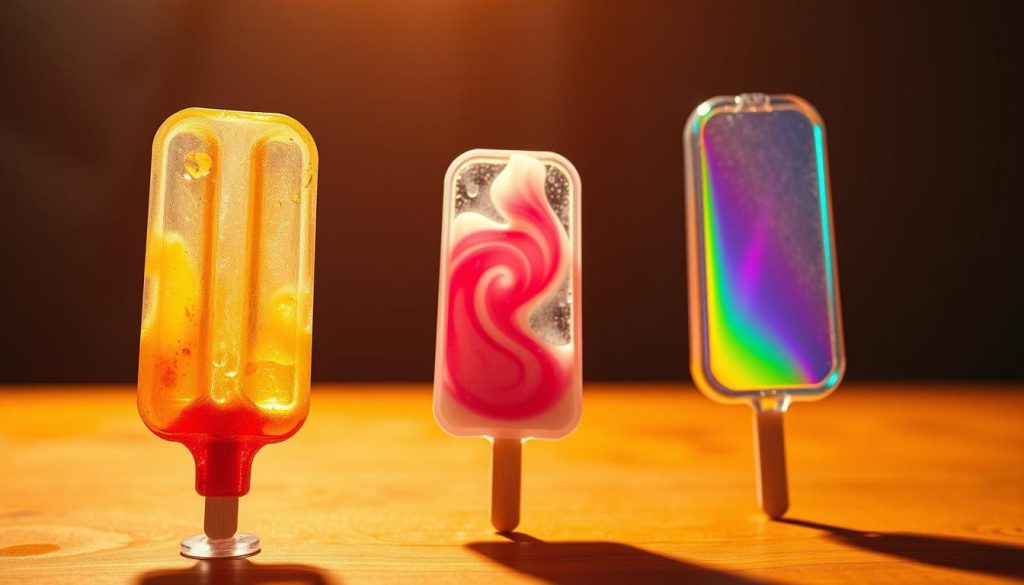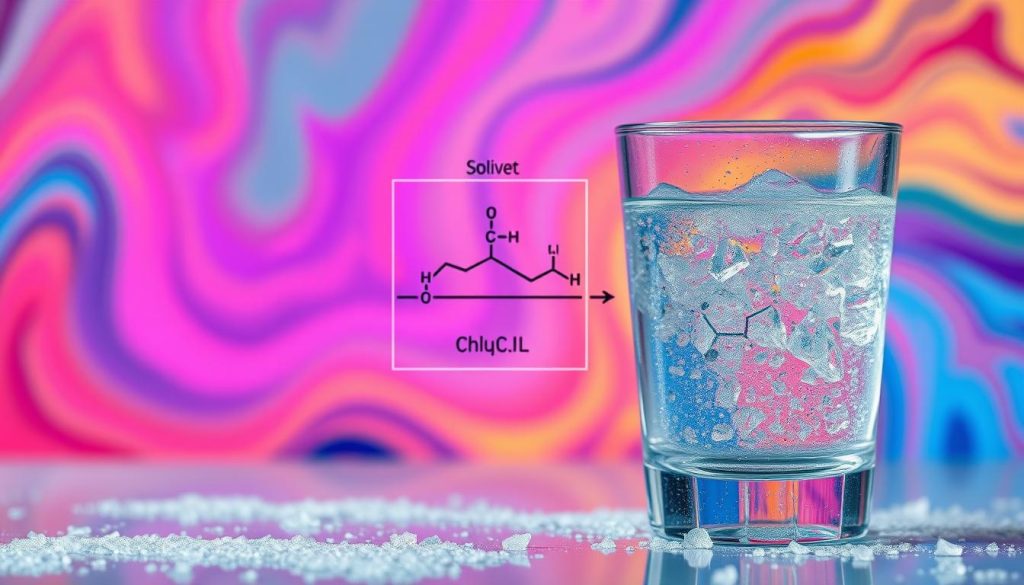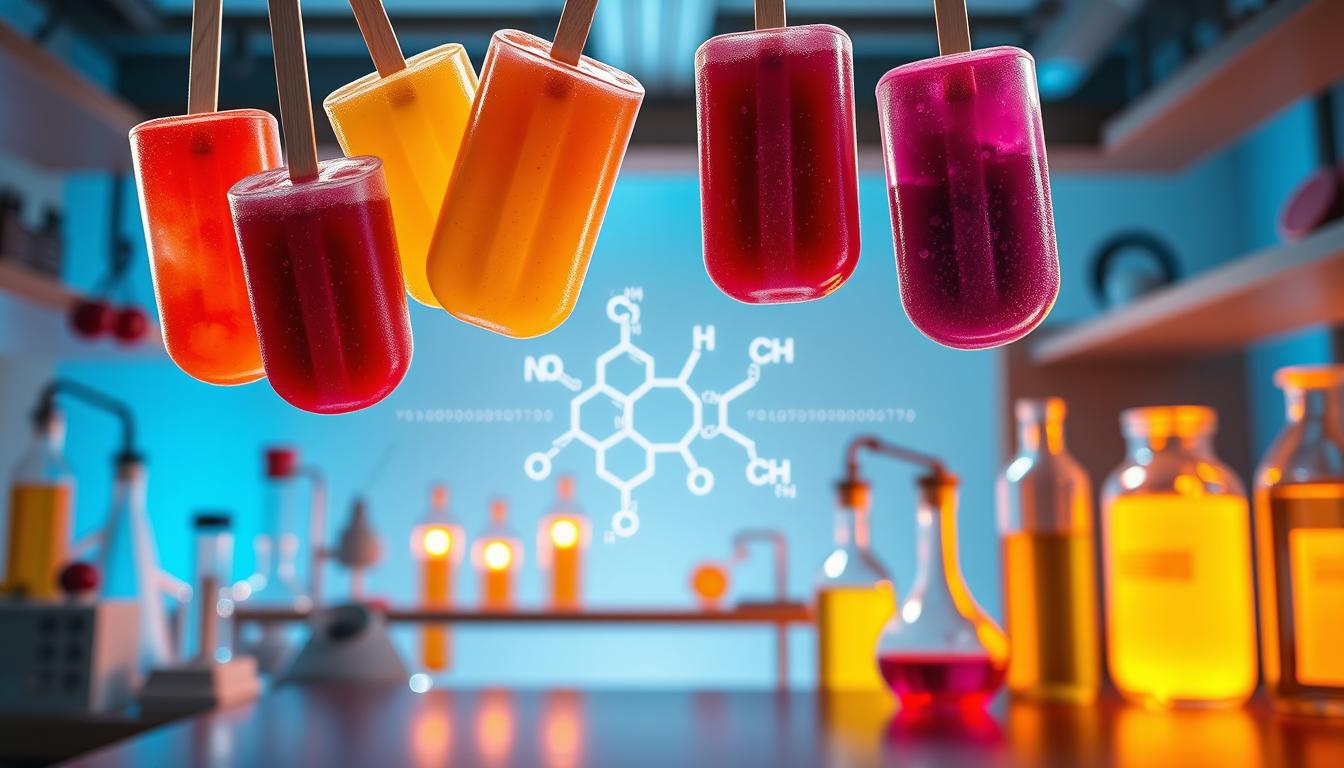Did you know a child’s forgetfulness sparked a billion-dollar industry? In 1905, 11-year-old Frank Epperson left a sugary drink outside overnight—and accidentally created the first popsicle. His frozen mishap became a staple of summer joy, blending childhood curiosity with scientific principles we still rely on today.
Why don’t these icy treats turn into solid blocks? It’s all about freezing point depression. Sugar molecules interfere with water’s ability to form rigid ice crystals, keeping popsicles soft enough to lick even in sweltering heat. This balance between sweetness and texture transforms basic ingredients into a refreshing escape.
Beyond cooling you down, these frozen delights tap into nostalgia. The act of unwrapping one triggers memories of carefree summers, while the slow melt offers a calming rhythm. Modern versions now blend classic flavors with bold twists—think mango-chili or lavender-lemon—proving innovation thrives even in simplicity.
Key Takeaways
- A kid’s accidental experiment in 1905 led to America’s favorite frozen treat.
- Sugar’s role in freezing point depression creates the perfect slushy texture.
- Nostalgia and stress relief make popsicles more than just a summer snack.
- Simple ingredients like water and flavorings drive lasting popularity across generations.
- Modern recipes balance scientific principles with creative, health-conscious flavors.
Origin and Evolution of Popsicles
Imagine a frozen treat born from a midnight experiment. In 1905, Frank Epperson left his powdered soda mixture outside with a stirring stick. Overnight frost transformed it into the first ice pop—a happy accident his kids later dubbed “Epsicle.”

The Sweet Taste of Adaptation
By the 1920s, seven vibrant flavors ruled amusement parks. Lemon, cherry, and grape stood beside quirky options like banana and root beer. Each five-cent treat offered escape during sweltering beach days.
Sticks, Sharing, and Survival
The 1930s brought genius design tweaks. Twin wooden sticks let friends split one pop during tough economic times. This clever version doubled sales while fostering connection—a nickel could buy joy for two.
| Era | Innovation | Impact |
|---|---|---|
| 1920s | Original 7 flavors | Diverse taste appeal |
| 1930s | Twin-stick design | Affordable sharing |
| 1940s | Medical hydration use | Polio care support |
World War II revealed new purposes. Doctors used these ice treats to soothe sore throats and hydrate sick children. What began as childhood fun became unexpected medical allies.
The Science of Popsicles and Flavor Release
Ever wonder why that frozen treat stays lickable straight from the freezer? The secret lies in how dissolved particles reshape water’s freezing behavior. Unlike solid ice cubes, these snacks maintain a perfect balance between firmness and meltability.
Understanding Freezing Point Depression and Mixture Composition
Pure water transforms to ice at 32°F (0°C), locking into rigid crystals. Add sugar, and everything changes. Sweet molecules disrupt water’s orderly freezing pattern, creating pockets of unfrozen liquid even at lower temperatures.

As the mixture chills, water molecules start forming ice first. This leaves remaining liquid more concentrated with sugar—like a flavor-packed syrup. Each freeze-concentrate cycle pushes the freezing point lower, preventing total solidification.
Temperature, Sugar, and the Slide to the Perfect Texture
Your freezer typically sits at 0°F (-18°C), far below water’s natural freezing point. But sugar-loaded solutions might only reach 15°F (-9°C) before stabilizing. This temperature gap creates the signature slush-like consistency that melts smoothly on your tongue.
| Property | Pure Water | Popsicle Mix |
|---|---|---|
| Freezing Start | 32°F (0°C) | 28°F (-2°C) |
| Final Texture | Solid ice | Slushy matrix |
| Key Components | H₂O molecules | Water + sugar + flavors |
Food scientists carefully calculate sugar concentration—too little makes icy bricks, too much creates sticky sludge. This delicate balance explains why homemade versions often differ from store-bought perfection.
Modern Innovations and Creative Recipes
Artisanal creators are rewriting the rules of frozen treats with bold ideas. Companies like Freezer Monkeys craft unexpected combinations—think blueberry-orange blossom swirls or smoky caramelized pineapple chunks. Farmers’ markets become testing grounds for seasonal specials, where rhubarb in spring and spiced pear in autumn steal the show.
Experimenting With New Flavors and Seasonal Inspirations
Weekly flavor rotations keep things fresh. Makers source ripe peaches during summer heat and roasted squash when leaves fall. This approach transforms local produce into edible calendars—a strawberry-basil pop tastes like June, while cranberry-clove screams December.
Healthful Twists and Natural Ingredients
Whole fruits now replace sugary syrups in many recipes. Blackberries pack fiber, mangoes deliver vitamin C, and avocado adds creaminess without dairy. Alternative sweeteners like honey or maple syrup let you control sugar content while maintaining that essential slushy texture.
Mastering Texture and Visual Appeal
Professional techniques prevent icy disasters. Xanthan gum (¼ tsp per 2 cups base) keeps mixtures smooth, while layered designs require precise timing—freeze each section 45 minutes before adding the next. For alcohol-infused “poptails,” balance is key: one shot per 1½ cups juice prevents complete solidification.
| Traditional | Modern Upgrade | Benefit |
|---|---|---|
| Artificial dyes | Beet powder/spirulina | Vibrant natural colors |
| Corn syrup | Agave/monk fruit | Lower glycemic impact |
| Single-flavor | Ombré layers | Instagram-ready designs |
Density tests ensure quality—drop a whole egg into your base. If a nickel-sized shell piece floats, your mix will freeze perfectly. These innovations prove frozen treats can be both nostalgic and nutritionally conscious.
Conclusion
What began as a sticky accident now stands as proof that great things often emerge unexpectedly. Frozen treats carry stories in every lick—stories of curious kids, sugar science, and shared joy across generations.
Mastering these icy delights means balancing freezing point depression with creative flair. Whether using twin sticks to split a pop during tough times or crafting layered ombré designs today, texture and taste remain rooted in careful chemistry.
Modern recipes let you reinvent this classic treat. Swap artificial dyes for beet powder. Blend ripe peaches with basil. Each creation becomes edible art while honoring the original balance of water, sugar, and nostalgia.
Hot summer days demand refreshment that sparks memories. A single pop can transport you to childhood—melting slowly as you race to catch drips. Now you hold the knowledge to craft new moments, whether reviving Depression-era flavors or testing bold fusions.
Grab molds and gather friends. Every batch you freeze writes another chapter in this delicious journey. From backyard experiments to farmers’ market innovations, frozen treats keep evolving while staying true to their sweet, sticky origins.



